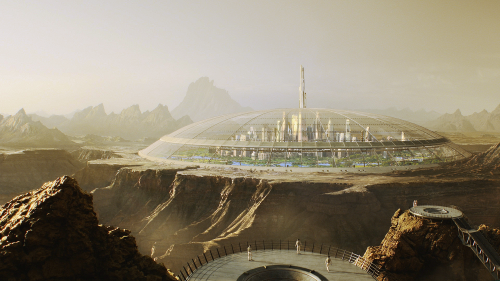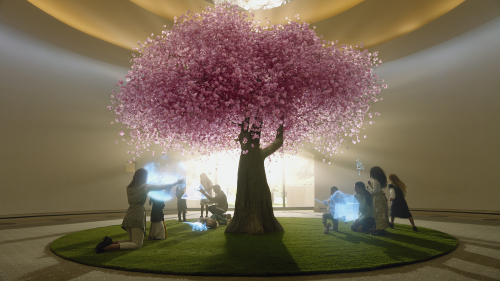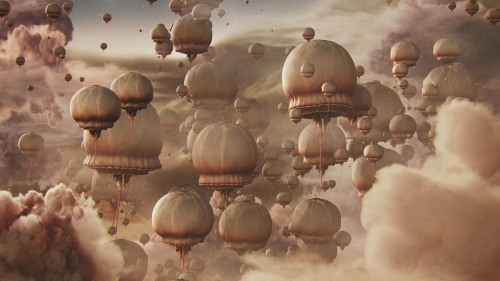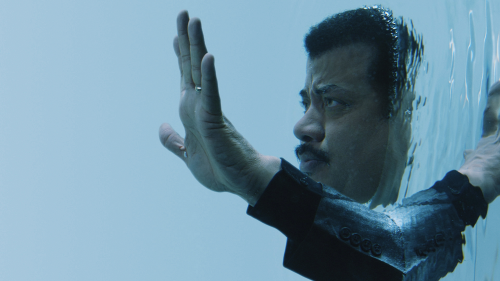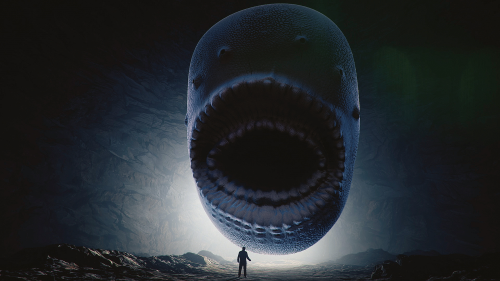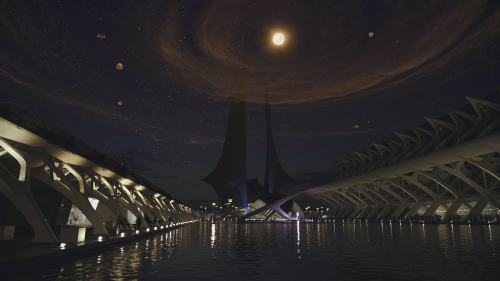Druyan: I am absolutely bursting with excitement about it, because it’s a way of examining a bunch of questions that have fascinated me my whole life, and it’s also an opportunity to tell some stories of profiles in scientific courage that are completely unknown and really deserve telling in a moment when the question of what’s true is so urgent.
This season of Cosmos emphatically deals with that question, as well as some of the more recent developments in science. It feels to me that this is a moment in the history of science when we are awakening to the other forms of consciousness on this planet, the ways of being alive and of understanding the environment on the part of other life forms on this planet.
Inevitably, if you’re interested in astrobiology and you’re interested in the question of intelligent life elsewhere, it requires a certain degree of self-consciousness about the life with whom we share this planet. [This season is] called “Possible Worlds.” So, we are exploring exoplanets, and we are imagining the deepest human future possible. Of course, inevitably, it’s also examining the shadow on that future that we all feel — that we should feel.
It seems to me that in every season of Cosmos, the question has always been: Are we ever going to be able to take the revelations of science to heart in the way that we take art to heart, the way that art affects us? Will we ever be able to really feel those things and awaken from our stupor and act? That’s the big question, I think, of our moment in history. Is there anything that can make us value the things we need to live — our air, our climate, our water — more than we value money? That’s the big challenge. Is there anything that can make us think in the timescales of science, not the timescale of the balance sheet?
We have to live with our descendants in mind. That’s the challenge. If Cosmos ever succeeds on any level, to me, that’s the critical one.
Astronomy: What led you and your associates to revive the series many years after Carl’s original?
So, after Carl’s death, I wanted to do another season of Cosmos. I joined forces with Steve Soter once again, and we invited Neil deGrasse Tyson to join us.
Steve and I created an outline for a new season of Cosmos, and for several years, we went from network to network, three in all. I think much to the horror of Steve and Neil and our other colleague, Mitchell Cannold, every network wanted to do Cosmos, but none of them would give me complete creative control, nor would they give me the money necessary to create the kind of cinematic, transporting experience that I felt very strongly Cosmos had to be.
So I was driving these guys crazy by saying no, without having another swing on the trapeze to grab ahold of, and just believing that it was better not to do it at all rather than to do something that would be designed by a network and budgeted by a network.
So, it didn’t happen for several years, until I met Seth MacFarlane. We had one of those great Hollywood dinners, where he promised me he would send me to the stars, that he would bring me to Peter Rice, who was then the head of the Fox television network and now has gone on to even greater things — and he did. Seth kept every single one of those promises.
He was absolutely passionate in his desire to see Cosmos. Not just that Cosmos would be a new season, that Cosmos would be produced, but that it would be on Fox, which was such an irony.
Of course, when Carl was alive and we were writing together, we didn’t write for the scientific publications. Well, he did plenty, but we wrote for Parade magazine, which was a Sunday supplement that reached 70 million people. We wrote about climate change. We wrote a piece called “The Warming of the World.”
This is going back to the ’90s and ’80s. It’s kind of dismal, actually, to think of how long scientists have been warning about the greenhouse effect of the building-up of carbon dioxide and methane in the atmosphere.
But anyway, the would-be producers said no, and then Seth brought us to Peter. He had missed the first run of the original series and was kind enough to say he would watch the DVD. He watched it with his kids, who were horrified that they were gonna be forced to look at what was then something like a 30-year-old science documentary.
But the thing that really turned Peter around was that his kids, after some chuckles at the beginning about Carl’s sideburns or whatever, they became obsessed with the show. They would call him at work and say, “Daddy, when are you going to come home? Can we watch another Cosmos?” That immediately persuaded him that it was time to do it.
I was thinking he was going to ask for a pilot. He said, “No. I’m ordering 13 from you.” I said, “Don’t you want a pilot?” He pointed to the DVD and he said, “No. That’s your pilot. You’re the only person on Earth who knows how to do this, so go do it.” He gave me absolute and complete creative freedom, and it was a tremendous joy to do it.
Besides Seth being our champion to Fox, the other thing that he did was he brought me together with Brannon Braga, who had a distinguished career in doing dramatic television — Star Trek and other series — very successfully. Brannon proved to be the absolute perfect collaborator for the second season of Cosmos, and now this third season of Cosmos.
So yeah, I have many stories that I want to tell, and I have a vision of what Cosmos, I think, really is.
Astronomy: In the second season overall, in 2014, the show had wandered considerably far from just astronomy. We heard about mechanics, chemistry, electromagnetism, and other subjects. Was that a big part of the show, not just to teach about scientific topics, but to teach people how to think scientifically?
In a book, I had read that Humphry Davy gave Faraday an assignment to do a chemical experiment that he knew would blow up in his face. Well, I thought, “Wow. That’s a great story.”
The idea that he had decided to do something to possibly kill his protégé was just so exciting — but, of course, when we did the research we found out there was no truth to the story, or, perhaps, just the tiniest alloy of some kind of reality. It was clear that he did resent Faraday.
Anyway, I love Faraday because, first of all, he was so modest. He was, in a way, probably more responsible for the Industrial Revolution in the modern world than any single person. He couldn’t do the math, which I related to. I loved that he had Maxwell to extrapolate his genius into mathematical equations.
The fact that he was a Sandemanian — he was a fundamentalist Christian and working in a laboratory with one of the most outspoken atheists of the day, and the two men adored each other — that was amazing. I just was fascinated by him because he seemed, to me, to be a man who wrestled with depression, and yet was probably one of the most productive minds in human history. So that’s how I got into electromagnetism.
Of course, if you understand what Faraday did, the way he understood it in non-mathematical terms, then that’s a doorway into the physics content and into Einstein, who of course memorably kept a portrait of Faraday above him as he worked. For me, Faraday was a three-fer, and I wanted the world to love him as deeply as I do.
Astronomy: That’s fantastic. Will the current season also have a mixture of astronomy and other allied sciences?
Druyan: Yes. It has a tremendous amount of biology, of neuroscience, and botany. We venture into many different fields. There’s also some quantum physics. We tried to be far-ranging — and one of the best stories that we tell is about how science required a reunification of different scientific fields in order to explore the world of our solar system and beyond.
I’m very proud of this thesis because I haven’t really encountered it anywhere else. Yet, Carl was very much both a product and an actor in that — a participant and an actor in that change at that time, when geologists and chemists and biologists had no interaction whatsoever. There wasn’t a single professional journal on Earth in which a biologist and a geologist and a chemist professionally had a conversation.
This was when Carl was coming of age as a scientist. So, again, we get to tell that story as well as that much larger story of science, and how science matured and changed as a result of our first baby steps into the cosmos.
Astronomy: Carl was really there at the dawn of the marriage of astronomy and chemistry, of so-called cosmochemistry.
Druyan: Exactly. He was the only shared student of both Harold Urey and Gerard Kuiper.
Astronomy: Yes.
Druyan: The two people who hated each other so much.
Astronomy: Right.
Here’s a kid who is lying on the living room rug in his parents’ little apartment in Brooklyn, and he’s mapping out the unfolding over the next 100 years of our exploration of the cosmos. The name of the drawing is “The Evolution of Interstellar Flight.” It’s so amazing to me.
That’s the amazing thing about Carl. He knew how lucky Fhe was because he got to live out his earliest, his wildest dreams. As he wrote so beautifully. When he was 5, he was taken to the 1939 New York World’s Fair. That’s where he realized, as he wrote, that there was such a thing as the future, and that the only way to get to it was science.
So, we go with Carl and his parents to the 1939 New York World’s Fair. Then we go along with Neil deGrasse Tyson to the 1964 New York World’s Fair. Because his father was an official, they named one of the monorail cars at the ’64 World’s Fair the Tyson Comet.
Astronomy: I’ll be darned.
Druyan: Yeah. So we go with Neil and his family to that — you know, first with Carl is that magnificent art deco, almost sepia kind of New York World’s Fair, and then with Neil is the Kodachrome World’s Fair that I remember so well, because I lived in Queens and I was a teenager at that moment. My brother worked at the fair, so I was there almost every week. I loved it.
One of the things we do in the new season is that we go to the 2039 New York World’s Fair, which is a vision of the future we can still have if we learn to use our science and tie technology with wisdom.
As I write in the companion book to the new series, this is where the future became a place that you could visit. It was a democratic vision of the future, small D, but also large D, too, I guess.
This is the thing I find so amazing. It’s 1939. The country is still mired in the worst global economic depression ever. It was about five minutes away from the most brutal, destructive world war in human history, the greatest bloodletting in human history. Yet, here are these people who are so in love with the future.
If they had known what the future was really gonna bring them, they probably would have been terrified. Any reasonable person would be, but they had a passion for the future, and that passion captivated Carl and so many others, with the idea of a world — when you look at Democracity, which was the name of the actual city at the New York World’s Fair in 1939, no slums. No slums. None of the inequality and tragedy.
What really excited me was — sometimes I like to just go around on YouTube and just search for things. YouTube is such a treasure trove of great musical performances and history and many things. In my searching, I found Einstein’s opening speech. He opened the New York World’s Fair.
Astronomy: I didn’t remember that. Wow.
This is how audacious and imaginative these people were, the greatest minds on Earth at that time, before or since for a couple of centuries. They said, “OK, we’ve got this World’s Fair. We’re gonna open it. What are we gonna do? I know what we’re gonna do. We are going to pluck 10 cosmic rays from the cosmos, and we are going to capture them on the roof of the Hayden Planetarium” — no kidding — “on the roof of the Hayden Planetarium, and we are going to transmit that energy from Manhattan to Queens. And after Einstein explains what a cosmic ray is, we are going to use the energy from a cosmic ray to illuminate, to perform the greatest path of illumination in human history, as this sphere bursts into light.”
So they said to Einstein, “You have to do it in 700 words.” He said, “Impossible. That’s impossible. I’m not gonna do it. It’s too complicated and we don’t even really understand what they are. So no way.” And they begged him, and he relented.
What I think is so brilliant is what his opening remarks were: “If science,” and I’m paraphrasing because I’m doing this from memory, “If science is ever to become fully realized in the same way that art has, its inner meaning will have to penetrate into the mind of the public.”
When he said that, I thought, “That’s the dream of Cosmos.” That’s what Carl and I have been doing all our lives. This is the idea of why people should take science to heart. If you really take the methodology of science to heart, the rules of science, then we would not be in the nightmare predicament that our country finds itself in at this moment. It wouldn’t be like that. We would have taught it to our children, so that they would understand that, above all, it matters what’s true.
You can’t lie your way to Mars. You can’t lie your way to the outer solar system and beyond. Because in all those iterations and redundancies and every step of every space program, manned or otherwise, the point is everybody has to get it right. You can’t fudge it. You can’t make it up. You have to tell the truth or else something terrible is going to happen and you will never get to where you want to go.
Astronomy: What is your hope for the new season of Cosmos in terms of influencing young people in how they think? We just talked about what a postmodern, ridiculous world we live in with regard to the truth now. How can Cosmos help young people?
Druyan: Well, I would love for it to be an awakening. To thaw that frozen sea inside of us that makes us act as if it’s all business as usual and as if we can just keep carrying on the way we are. That would be wonderful: a new respect for scientists and for the value, the message of science, new standards or old standards of evidence reintroduced into our political culture, so that lying becomes unacceptable, no longer a tenable way to get power.
These are survival issues. If Cosmos could awaken those feelings — we feature several scientists in this season who literally were willing to die, to be tortured to death, rather than embrace pseudoscience or lie about science. You know, it’s my hope that when the pendulum swings so wildly in one direction towards falsehood and fantasy, that it means that it’s going to be swinging back equally in the other direction.
I’m 70 years old. I’ve never seen any kind of time in American history like this one. I mean, there has been progress from a very racist, homophobic, anti-female society. We still have miles to go. But we made some progress. Yet, we have devolved in the area of respect for reality.
Astronomy: It’s very disheartening to many of us who are working very hard to try to continue the respect for truth and for science that you and Carl worked on so hard. Frankly, the truth, scientific truth, it’s more exciting than the fiction.
Druyan: Absolutely. We’re not as good at making up stories as reality and nature. They make up the best stories. And ours, you can see through them. Unless they contain a lot of truth of their own, they wear thin very quickly.

